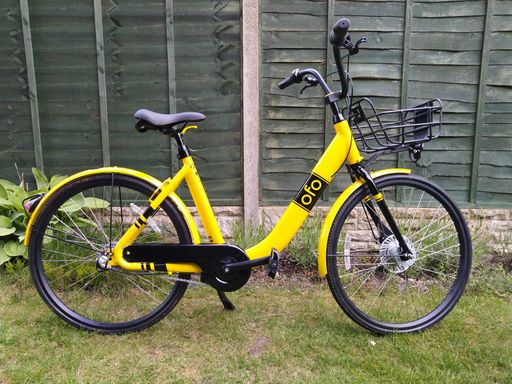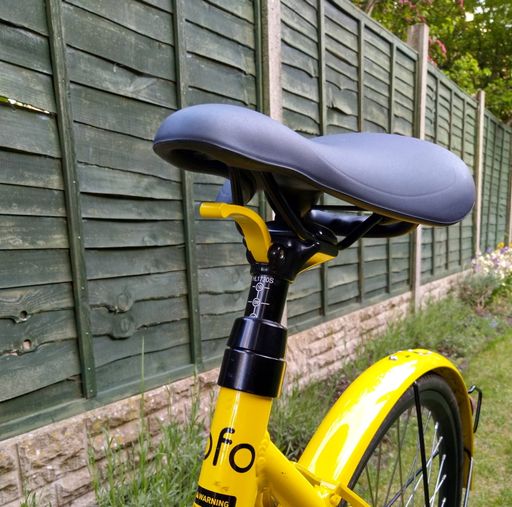The summer before last, when the world had not yet descended into a dystopian plague-ridden nightmare, I convinced my wife to get a bike. Her daily train ride to work wasn’t expensive, but the weather was nice and it seemed silly to stand on a crowded train when a bike would do the trick for free. After a modest initial investment, anyway. This was that investment.

You recognise this, right? It’s a Ofo bike, once available for hire via a smartphone app, and one of a wave of similar dockless bikes that appeared from nowhere in 2018 or thereabouts. Oranges Mobikes, citrus Limes, banana-yellow Ofos; for a brief moment, fruit-themed hire bikes were absolutely everywhere. And then they weren’t.
Ofo had a particularly spectacular flame-out. Having raised more than $1.5bn from the likes of Alibaba and Didi Chuxing (a ride-hailing company) by early 2018, in early 2019 Ofo pulled out of the London market and by August that year it had stopped answering the phones. It was a rocky road, too, not just a downward one: Ofo bikes were dumped in rivers, up trees, and on railway lines, and at least a few muggers used them as getaway vehicles. Granted, there was a certain amount of manufactured hysteria about all this – the Daily Mail managed to inject a bit of xenophobia, frothing at the mouth about a “flood” of “Chinese” bikes – but there was some truth behind it, with the Guardian reporting that Ofo had pulled the plug on its UK operations in part because of problems with vandalism.
So: where did all the bikes go? At the height of the bike-share boom, there were something like twenty million hire bikes in China, by far the largest market. Ofo, one of the biggest players, had 6,000 in the UK alone. It’s hard to find any concrete information about what happened to those UK bikes, but there are a few clues. At least one US bike made its way to a police auction, for instance, while in Singapore, almost 8,000 were sold at public auction. If the same thing happened here, I can’t find any evidence of it, and yet, at the time of writing, Ofos are still to be found on Gumtree, on eBay, and in the classifieds. Perhaps a container went “overboard” from a ship en route to Beijing? This faint whiff of mystery was one of the reasons why, on a hot day on July 2019, we made a pilgrimage to a bric-à-brac shop in Sparkbrook.
When we asked about the four yellow bikes the shop had posted on Gumtree, the owner took us to a white van parked on the pavement a few blocks down. One solitary bike was in there, already promised to another customer, but the owner asked if I wanted to take a test ride all the same. I did indeed.
I stuck to the broken pavement to avoid the nose-to-tail stream of Beemers, Mercs and Audis that crowded the melting tarmac of the road. The Ofo seemed of a piece with the Just Eat bikes I use occasionally in Edinburgh, or the Santander bikes in London – a tank, but a well-screwed-together tank. Worth a punt at eighty quid, we agreed, so we left a deposit and promised to pick up our own Ofo the next weekend.
That second weekend, on the ride home across a few miles of town, I got to know the Ofo a little better. The first thing I realised was that it was much more normal than a Santander or Just Eat bike: there were no spats on the rear wheel, no fairings to protect the brake and gear cables on their journey from the bars to the wheels. The Shimano hub brakes were fine; ditto the three-speed hub and dynamo. That normality came to an abrupt and unhappy halt at the solid 26″ rubber tyres (once a bike share staple, now ditched by everyone except Lime), which gave the bike a harsh and occasionally nervous ride.
There were other problems, too. The cranks were too short and the gearing too long, with two of the hub’s three ratios unusable for anything except a downhill grade with a following wind. The seatpost was adjustable, at least, although not by much: I’m 5’9" or thereabouts, but even with the seat at its highest point my knees were bouncing off my chin.
There’s an episode of 99% Invisible that talks about the time, back in the 1950s, when the US Air Force measured thousands of its pilots and found that not one of them was average across all of their measurements. Which was a problem because, since 1926, the Air Force had been designing cockpits for the “average” American male. Planes were crashing because their pilots just did not fit. The solution was to introduce adjustable seats, pedals, straps, and so on, but in the Ofo’s case its single point of adjustment didn’t make enough of a difference. Even on that short ride home, I couldn’t get comfortable.

Back at home, I took a closer look. There were some neat touches, I had to admit: a steel bracket at the bottom of the head tube to stop the front wheel swinging all the way round. A gripshift-style bell. A sturdy-looking front basket. A guard over the hub gear’s cable mechanism. The execution, however, was less impressive. The bell thunked rather than dinged. The mudguards, the basket and the bars were all misaligned and, unhelpfully, they were all secured with proprietary Torx bolts that I couldn’t adjust. I ordered some specialist Torx bits that looked like they might work.
One of the main reasons we bought the bike in the first place was an aspiration to cart around our toddler on sun-dappled family rides through a litter-free, beatific Birmingham that doesn’t exist. We already had a Hamax child seat mounted on my commuter bike, and I’d hoped to simply bolt an extra seat tube bracket onto the Ofo and call it a day. Of course, the Ofo rebelled. Perhaps to stop renters from doing exactly what we wanted to do, the seat tube had a teardrop profile that wasn’t compatible with the Hamax bracket, and nor were there any rear rack eyelets. I thought about trying to hack something together using the mounting plate for the now-absent wheel lock, but I didn’t see an obvious way to make it work. I put the bike back in the shed and told myself I’d tackle the problem another day.
A few days later, it occurred to me to give the bars a yank to see if I could realign them without having to undo the steerer bolt. I could, and I did. Those Torx bits have yet to leave their box.
In the spring this year, just as the ’rona was starting to take hold, we took some photos of the Ofo and put it on eBay for £50. I tried to work out how many times it had left the shed in the intervening nine months, and I couldn’t even reach double figures. It fitted my wife, but it was too heavy and over-geared for her commute. I liked the idea of it, but the solid tyres and the awful fit more than took the shine off that idea. It was time to get rid of it.
The Ofo was sold within the hour, bought by an old gent up in Harborne with a brain injury and a garage full of secondhand bikes. He was surprised but not deterred by the solid tyres, and chatted about how he’d always wanted a yellow bike. I said goodbye and walked home, and, with that, our Ofo experiment was over.